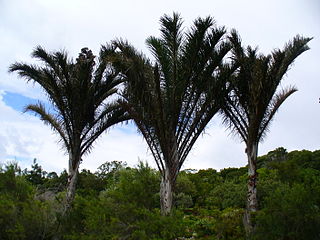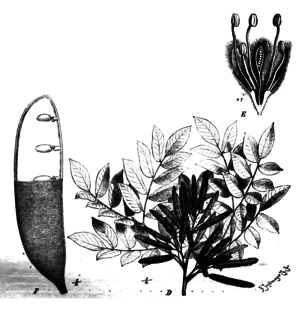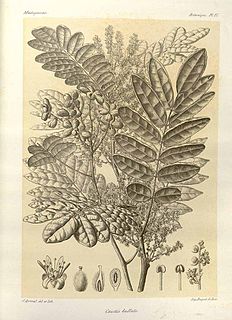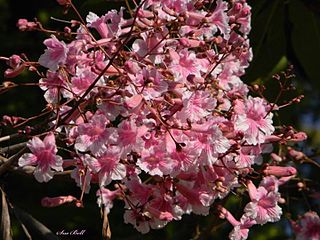
Pterocarpus angolensis is a species of Pterocarpus native to southern Africa, in Angola, Mozambique, Namibia, South Africa, Swaziland, Tanzania, Zaire, Zimbabwe,and Zambia. It is a protected tree in South Africa. The name Kiaat, although Afrikaans, is sometimes used outside South Africa as well. In Zimbabwe, depending on what region you are in, it is known as Mukwa or Mubvamaropa.

Leucosidea sericea, commonly known as oldwood, is an evergreen tree or large shrub that grows in the Afromontane regions of southern Africa. It is the sole species in the monotypic genus Leucosidea. The name oldwood may reflect the fact that the wood burns slowly as if old and rotting, but the gnarled twisted trunks reinforce this impression.

Raphia australis, the giant palm or rafia, is a species of raffia palm in the family Arecaceae. It is found around Kosi Bay in southern Mozambique and northeastern KwaZulu Natal in South Africa. It is threatened by habitat loss caused by drainage of its habitat for agriculture; it is being threatened in the Bobole Special Reserve but is more secure in the Kosi Bay area.

Annona senegalensis, commonly known as African custard-apple, wild custard apple, wild soursop, sunkungo, and dorgot is a species of flowering plant in the custard apple family, Annonaceae. The specific epithet, senegalensis, translates to mean "of Senegal", the country where the type specimen was collected.
Jasminium abyssinicum is a species of jasmine, in the family Oleaceae.

Millettia grandis is a species of legume in the family Fabaceae from South Africa. It is commonly called Umzimbeet which is a name derived from the isiZulu name umSimbithwa.

Deinbollia oblongifolia is a shrub or small tree in the family Sapindaceae. It is commonly known as the dune soap-berry and is found in coastal vegetation from the Eastern Cape of South Africa, through KwaZulu-Natal to southern Mozambique and Swaziland. It is named after Peter Vogelius Deinboll (1783-1876), a Danish botanist and plant collector.

Southern African Sand Forest is a sand forest, or a subtropical forest plant community of the tropical and subtropical dry broadleaf forests biome. It grows on ancient sand dunes in northern KwaZulu-Natal and southern Mozambique. In South Africa these forests are known simply as Sand Forest, while in Mozambique they are known as Licuati Forest. The Southern African sand forest is part of the Maputaland coastal forest mosaic ecoregion.

Capparis fascicularis, the zigzag caper-bush, is a plant in the Capparaceae family and is native to Africa.

Erythrophleum suaveolens, also known as the ordeal tree, is a species of plant that can be found in Mozambique and Zimbabwe. The species are 20 metres (66 ft) in height, and have a rough and blackish bark. The plants leaves have 2–3 pairs of pinnae, which carry 7–13 leaflets. The leaflets are 5 by 2.5 centimetres, are green coloured and ovate. The flowers have fluffy spikes, and are creamy-yellow coloured. Fruits are hard, the pod of which is flat.

Diospyros dichrophylla (Gand.) De Winter is a Southern African tree belonging to the ebony family of Ebenaceae and closely related to the Persimmon.

Erythrina zeyheri, commonly known as the ploughbreaker, is a deciduous, geoxylic subshrub and member of the Fabaceae, which is endemic to southern Africa. It grows no more than 60 cm tall and occurs naturally in the higher altitude grasslands of South Africa's central plateau, and that of adjacent Lesotho. They favour deep clay soil in the vicinity of creeks and marshes, and often form colonies. Its specific name commemorates the 19th century botanist, Karl Zeyher.

Newtonia hildebrandtii, the Lebombo wattle, is a medium-sized tree native to eastern Africa. It is a protected tree in South Africa.

Maerua cafra (DC.) Pax is a small Southern African tree belonging to Capparaceae, the caper family, occurring eastwards along the coast from Knysna, then further inland and northwards through KwaZulu-Natal and Swaziland to the Transvaal, southern Mozambique and southern Zimbabwe. The genus Maerua comprises about 60 species found in Africa and Asia.

Dalbergia armata is a scrambling, deciduous species of legume that is native to subtropical to temperate regions of southeastern Africa. The robust, woody liana or small tree is armed with strong spines on the main stem and branches. It occurs sparsely or commonly in forest, bush, riparian fringes and in wooded ravines. It is sometimes employed as a bonsai subject, and it can be propagated from either seed or cuttings.

Cnestis polyphylla, or itch pod, is a liane or scrambling shrub belonging to the family Connaraceae and occurring south from Kenya in East Tropical Africa through Mozambique and Zimbabwe to Southern Africa where it is found in coastal and escarpment forest in Limpopo, Mpumalanga, Swaziland and KwaZulu-Natal, and further south to the Eastern Cape. It also grows on the Indian Ocean islands of Madagascar, Mauritius and Réunion. The genus has at least 13 species with many still unresolved. They are distributed mainly in tropical Africa and nearby islands, but extend to SE Asia and China.

Stereospermum kunthianum is an African deciduous shrub or small tree occurring in the Democratic Republic of Congo, Djibouti, Eritrea, Ethiopia, Kenya, Malawi, Senegal, Somalia, Sudan, Tanzania and Uganda. It is widespread across Africa to the Red Sea, and reaches as far south as Angola, Mozambique, Zambia and Zimbabwe. There are some 30 species with a Central African and Asian distribution.

Encephalartos natalensis, the Natal cycad or giant cycad, is a species of cycad that is endemic to the Qumbu and Tabankulu areas of the northern part of the Eastern Cape, and through most of KwaZulu-Natal. The number of mature individuals of this species is declining and the International Union for Conservation of Nature has assessed its conservation status as being "near threatened".

Dracaena mannii Baker or small-leaved dragon tree, is a small to medium-sized tree, though recorded up to 30 m tall with stem to 2 m in diameter in Cameroon and Gabon. It occurs from Senegal to Angola along the African west coast, is widespread in tropical Africa and is found along the African east coast from Kenya to Kosi Bay in northern KwaZulu-Natal. It prefers lowland, submontane and montane forests which are either moist and evergreen, swampy or on coastal dunes. It is also found along forest edges, in clearings and on river banks from sea level to 1,800 metres. It is one of some 120 species currently recognised, which occur primarily in Africa and southern Asia with a single vagrant species in Central America. The species is named after Gustav Mann (1836–1916), a German botanist, who corresponded with John Gilbert Baker.

Drypetes arguta, commonly known as the water ironplum, is a species of small tree or large bush in the family Putranjivaceae. It is native to tropical East Africa. It was first described in 1920 by the English botanist John Hutchinson, who named it Cyclostemon argutus. It was later transferred to the genus Drypetes.





















